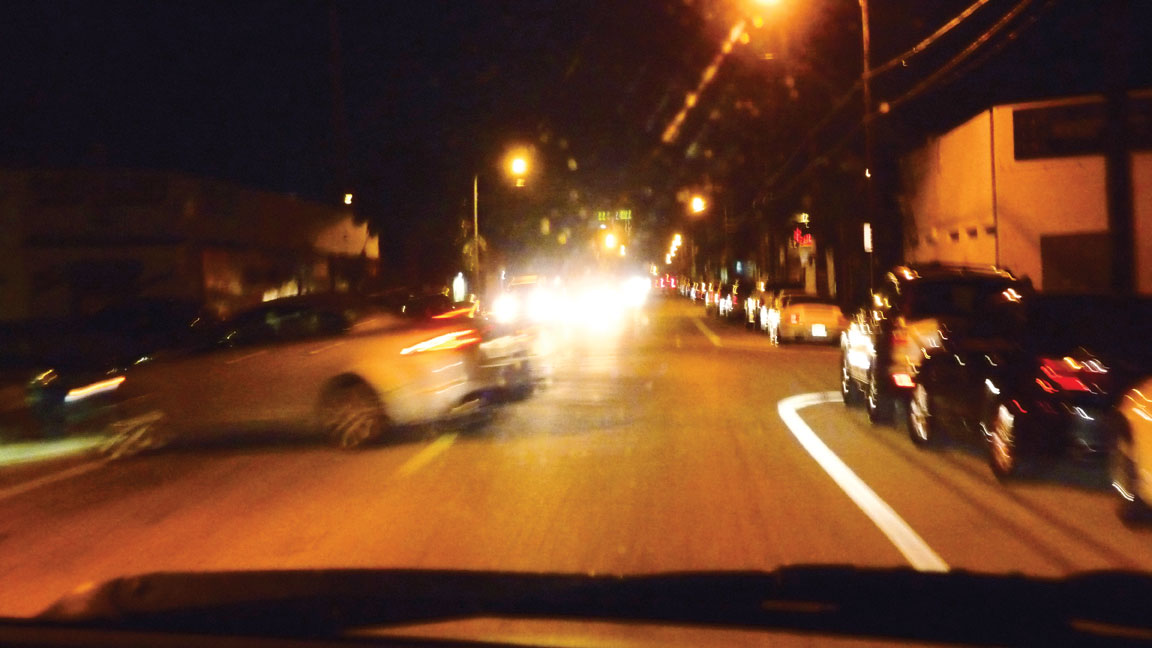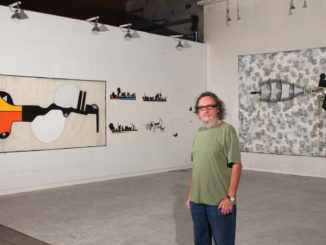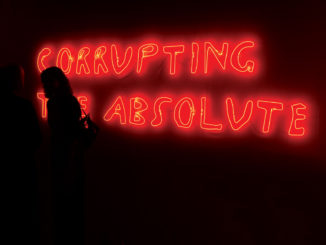
In 8 short years, Wynwood went from total obscurity to internationally recognized arts hub – and now, it may be on the verge of a new journey once again. As Art Basel Miami Beach hits the sands for a 7th year, and as the global economic earthquake starts to give even the art world tremors, it seems a good time to take a look at our art heart – what was, what is, and what could become of Wynwood.
The urban core of Wynwood didn’t start out to become one of the hottest art spots in the country. The predominantly working class neighborhood, heavily Puerto Rican and once the wholesale outlet district of Miami, has seen some tough times. Unemployment is high, the homeless numerous, the windows too often boarded up. While many of the colorful ‘50s warehouses are charming, the area isn’t on its face an attractive destination for a stroll.
But then comes a monthly second Saturday evening, when the place is jumping, filled with spirit (and spirits), young and old, rich and poor, and mostly, filled with art. The second Saturday opening that kicked off this year’s season in September topped them all, with up to 20,000 people crawling the streets. Something significant, clearly, has happened here. And unlike so much else in this city, dominated by developers and their whims, this art scene was a grass roots, homegrown movement.
And what an amazing amalgam of artists, shows, galleries, museums, and interesting interlopers went into the makings of that “movement.”
So let’s step back to the year 2000 – the dawn of the era of Wynwood, before there were condo colossals and lots of Lexuses, and just as an emerging art-scene was bursting out with crazy energy in Miami. Brook Dorsch had just transplanted his gallery into a sprawling warehouse here, joining a few lonely others such as Locust Projects and the Bakehouse, and soon thereafter Damien B, and a little further north, Bernice Steinbaum.
The motley crew of artists and fellow travelers who stumbled over car parts and broken glass to hit these spots found themselves almost as integral to the shows as the art itself. There was a real bohemian feel to those openings, which often included musical jam sessions, free beer, and an anything-goes atmosphere.
While most galleries were based in Coral Gables, North Beach, and the Design District, Wynwood, literally and figuratively, was on the edge. On the very edge (and actually, in Edgewater), some just-out-of-school artists opened up an alt space called The House, and in 2001 asked artist Robert Chambers to curate a show at their abode. The outrageous and infectious “The Sears Building” exhibit that resulted set the tone for much of what would follow – it was more a “happening” than anything resembling a typical art show, and it was all local.
The work of some 60 artists was shoved on walls, staircases, in the kitchen, while performance artists prowled the grounds and the rooftop, and D.J. Spam provided the soundtrack. “Sears” seemed to propel Miami’s art scene into hyper-high gear, and it wouldn’t be taking off from the Gables.
The intense energy of that show seemed to migrate over to the original bad-boy gallery of Wynwood, Rocket Projects, opened in 2002. It morphed into the place to see cool, alt-art and where the party almost literally never ended. Numerous artists first popped up in Rocket’s space, names that today are ubiquitous about town. And in the patio out back, Wynwood revelers danced the night away.
Remembers one of Rocket’s featured artists, Sara Stites, when she had her show: “There was an empty train yard across the street, so we parked up there, on what would become the sidewalk, but then was just a scrappy rocky area.” Today, Midtown Miami occupies the space.
That same year, the tidal wave of Art Basel first hit Miami Beach, and its excitement flooded the whole city. Suddenly, the visual arts scene became the cultural scene, bar one.
Back then, adventurous visitors who crossed the causeways may have encountered Gretchen Bender, the real estate agent hawking the crackhouse next to the Dorsch Gallery. She wasn’t really an agent, and she wasn’t really a woman. It was a show of performance artist David Rohn, called “Le Chateau del Pueblo,” and it provided one of the more memorable moments of the time. In the middle of those dark, decrepit streets, Ms. Bender tried to sell us a “chateau” – a clever take on the “edge” on which Wynwood perched.
Wendy Wischer, now one of the main artists in David Castillo’s gallery, remembers the “rum drinks out of coconuts” at The Yard@Casa Lin. This tropical garden outside of Lin Loughheed’s Wynwood house has been transformed every December into a quirky, uniquely Miami space, showing local art strewn about the flora and fauna of Lin’s yard. While sipping out of those coconuts, visitors to the garden may have listened to the earth, through headphones attached to subterranean microphones, courtesy of sound-artist Gustavo Matamoros; or played musical chairs with on online champion through a Web Cam, thanks to multi-media artist Mark Koven.
TransEAT might have left the strongest taste in the mouths of gallery hoppers back then. The Spanish couple Montse Guillen and Antoni Miralda opened up this Wynwood space to highlight their experimentations with both art and food. Along with eerie or humorous installations, Guillen might have served up “fried giant water beetles wrapped in bacon and figs, tempura scorpions, and larvae-filled communion host.” Always, there was music here too.
By 2004, Wynwood hit a crescendo – still edgy, still alternative, but far from empty.
{mospagebreak}
Heavy hitters Fred Snitzer and Chris Ingalls would leave their respective homes (effectively signally the end of Coral Gables and North Miami as art centers) for the grittier but greener pastures of Wynwood. The mega-collectors Martin Margulies and the Rubells revamped and reopened their mega-spaces, and Parisian big-wig Emmanuel Perrotin moved in, all creating a critical mass of art outlets to make Wynwood the destination for art, with a growing national rep.
And still, quirky art cropped up in expected and unexpected places, from one-off shows in empty spaces to exhibits such as “Dirty South” at the multi-story World Arts Building, produced by the nomadic Worm-Hole Laboratory. On the top floor, the always-intriguing Venezuelan Eugenio Espinoza played with perception with his installations, and at mid-level Jay Ore unveiled some Polaroid UFOs – he would later “hover” some UFOs over the space during last year’s Art Basel. And on the ground-floor, in true Dirty South fashion, performance artist Jasmine Kastel drank rum and “interacted” a little too literally with Charo Oquet’s piece. It was a wild and crazy and ultimate Wynwood night. That year Brook Dorsch inaugurated The Dixie Dingo Super-8 Invitational Film Festival, where 8 average Miamians were asked to shoot super-8 films of their lives in 3 minutes. Creative stuff that did Wynwood proud.
Outside of both the World Arts Building (which became home to Oquet’s non-profit Edge Zones projects) and Dorsch’s gallery, Ore remembers in particular “K-man showing up, being unexpected and bizarre.” He’s referring to Art Kendallman, the eclectic and indeed beautifully bizarre artist, who would show up as a spaceman or some other kind of extraterrestrial visitor at various openings, a one-man exhibit. Sadly, Kendallman took his life this year.
Ore also recalls “anything related to people running from muggers,” of which there were infamous – and sometime apocryphal – stories. Unfortunately, that aspect has not changed too much in Wynwood, but so much else has.
There are of course many other memorable moments, and incredible shows – for instance at the relocated-to-Wynwood Kevin Bruk and Diana Lowenstein galleries, or at new outlets such as Kunsthaus, Hardcore Contemporary, Pan American Art Projects, David Castillo, Spinello, the Diet Gallery, Twenty Twenty and so many others.
In a sense, Wynwood grew up. Some of the madness is gone, and the god of mammon reigns. The scene is more staid and conservative, and the business of art, for better and for worse, now defines the landscape.
And while there are now over two dozen satellite art fairs that take place in Wynwood during Art Basel, other artistic outlets have disappeared, such as Ingalls, Ambrosino, TransEAT, Rocket Projects, and others.
Yet, flashes of its old self remain. During Basel, artists such as Ore and Steven Gagnon with his police-car immigration patrol take their art, on their own, out onto the streets. This past September, Miami got to experience the delightfully weird, freakish, and wonderful adult-theme park world of Clifton Childree.
The artist best known for his sepia-toned films that are both humorous and creepy – and most of all, masterfully executed – took over Locust Projects, and with sand and tons of refuse collected in Little Haiti, transformed the white cube into a turn-of-the-20th-century carnival. The stunning result left the hordes of visitors to Locust on opening night with the feeling that magic can still happen in Wynwood. And while the march toward total commercialization of the art scene seemed almost inevitable just a few months ago, a world-wide recession has stepped in and most likely will put the breaks on this forward motion.
Next year at this time, who knows? Artists might be making art with the knowledge that much of it may not sell, might be freed up to make art for art’s sake, not for a collector’s living room. And Wynwood might return to its incubator status as a hub that nurtures creativity and craziness, not just big price tags. Who knows?



Be the first to comment